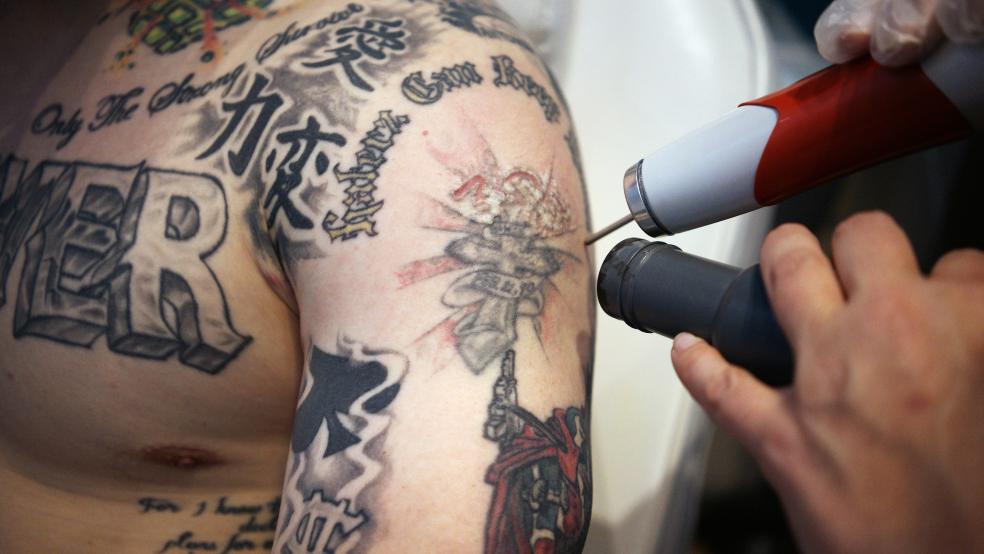Standing outside a restaurant in Northern Virginia this weekend, a friend gestured toward a strip mall across the road. “That’s a business I should have invested in,” he said, pointing to a sign that simply said, “Tattoo Removal.” “Once you get settled down and have a couple of kids, that tramp stamp isn’t as appealing anymore.”
Bloomberg News just confirmed his rueful suspicion: “Removing the skin designs has become a roaring trade, with one in seven people expressing misgivings — some enough to spend thousands of dollars for several searing laser sessions,” Jason Gale reported.
Related: Corporate Logo Tattoos Take Brand Loyalty to New Heights
The American Society for Dermatologic Surgery says its members performed about 96,000 tattoo removals procedures last year, up 52 percent over the year before, as Bloomberg notes.
On the other hand, dermatologists and plastic surgeons surveyed by The American Society for Aesthetic Plastic Surgery reported performing 45,224 tattoo removal procedures in 2013, up from about 41,000 in 2011 but down from more than 58,000 in 2012. (Roughly two-thirds to three-quarters of the patients getting those procedures over the last few years were women, according to the plastic surgery group.) But the group’s statistics didn’t break out “tattoo removal” as a category until as recently as 2010.
A 2012 Harris Poll found that 21 percent of U.S. adults have at least one tattoo, up from 16 percent in 2003 and 14 percent in 2008. That’s 45 million people bearing ink. A more recent poll on behalf of NBC News and The Wall Street Journal found that 20 percent of respondents reported having a tattoo and, in a companion survey, 40 percent said someone in their household had a tattoo, up from 21 percent in 1999.
While blue-collar households (60 percent) were more likely than white-collar ones (47 percent) to have someone sporting ink, and those ages 18 to 34 were more likely to live in a household with a tattoo than those in older groups, the increased presence of tattoos over 15 years was similar across all those groups.
“Now, it is worth noting that another phenomenon may be at play in these numbers,” Lori Weigel, a partner at Public Opinion Strategies, wrote in detailing the poll results. “There are significantly more households with a young adult who has returned to the nest. So some of the jump in the [household] numbers could potentially be attributed more to the new norm for living arrangements than for a penchant for body art. That said, it is clear that those most likely to indicate ink in the household do tend to be younger.”
Removing a tattoo is harder and more expensive (and likely more painful) than getting one, and tattoo parlors have found that removal services can be a lucrative extension of their business. Sales of removal-related equipment at publicly traded companies are on the rise, Bloomberg notes.
“Several types of laser systems may be used to eliminate tattoos, depending on anatomic location, size and ink color,” according to the Dermatologic Surgery society. The lasers break down the pigments in the tattoo and make them easier for the body to absorb, fading the unwanted artwork. Newer “picosecond” lasers sold by companies such as Cynosure Inc. fire shorter bursts of energy at the skin. Those machines reportedly sell for between $200,000 and $300,000, but they can reduce the number of treatments required to remove body art.
Still, if getting a small tattoo costs an average of $45, each laser treatment to zap it away can costs several times that. Lighter colors like green, red and yellow are the hardest to clear. “Unfortunately,” as the Food and Drug Administration said in a consumer update last year, “removing a tattoo is not as simple as changing your mind.”
All that unwanted ink now spells a growing business opportunity, but for consumers the lesson is clear: Think before you ink
Top Reads from The Fiscal Times:


